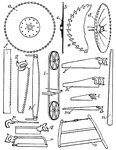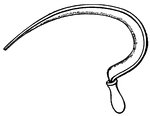Clipart tagged: ‘slice’

Guillotine
(1.) The guillotine is an instrument employed for the purpose of decapitation. It was officially introduced…

Purchase Shears for Cutting Metal
A tool used for cutting metals. "a and c, levers connected by a link bar b, and respectively pivoted…

Collection of Saws
This illustration includes numerous types of saws: a. Circular saw (right-hand and left-hand saws have…

Sickle with Serrated Edge
"A reaping hook; a curved blade of steel (anciently also of bronze) having the edge on the inner side…
Slice Galley
"In printing, a galley with a false bottom, in the form of a thin slice of wood, which aids the removal…

Wood Cutting Tool
In wood working there are a number of fine tools used in cutting wood, in which a single or double shearing…